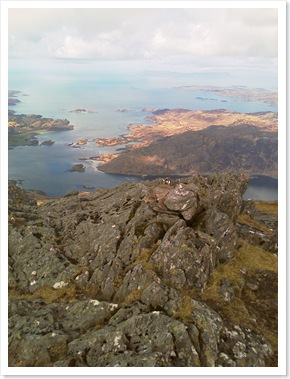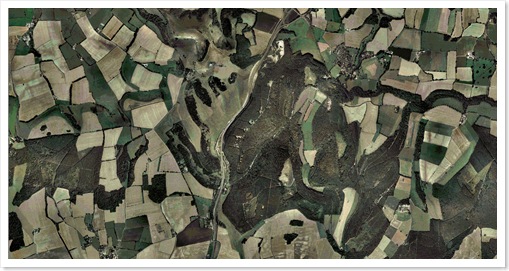April 2009
Monthly Archive
April 29, 2009
The Editor of the Countryfile Mazine forum has taken up one of my previous postings on this blog to start a new discussion. If you haven’t already had a look at the Countryfile website take a look and whilst you’re there join the debate.
I’m a blogaholic and will spend hours wading through the musings in what I’m told is called the blogosphere or some such by techy people on the bleeding-edge.
Anyway, I followed a link on Papagenos’ profile to his blog and found this fascinating post on GPS handhelds and whether they will cause a drop in map sales.
What do you think? Will maps finally fall in the face of digital devices?
via View topic – Maps vs. GPS devices • Countryfile Magazine.
April 24, 2009

The Lochailort Pyramids
When asked to name the classic ridge routes in the Scottish mountains most hillwalkers would list Aonach Eagach, CMD arete, Forcan ridge and the Skye Cuillins among them. I suspect few would mention the Lochailort Pyramids hidden away in Moidart. That’s a shame as they offer a delightful day out in the hills, albeit one that does not involve tricky scrambling or nerves of steel to edge along exposed sections. Even better their relative anonymity means that you will have the three Corbett peaks and their interconnecting ridge virtually to yourself. Even on a fine Easter Sunday there were few out on these hills. In comparison, the Aonach Eagach would have been more crowded than the M6.

Starting from the small car park at Inverailort our walking club split in to two groups with the larger group opting to undertake the horseshoe route, whilst my smaller group headed off to tackle An Stac. Comments from walkers that had already climbed An Stac included, “It is relentlessly steep” and “I know if I climb An Stac I won’t want to continue beyond it.”
Yes, the north ridge of An Stac is steep but I have been up steeper. From the col below it does look at though the climb will go on for ever, but on a clear day you are rewarded with views of the azure clear waters of Loch Ailort and the Sound of Arisaig. Beyond An Sgurr on the Isle of Eigg points stubbornly upwards from the low lying island around it. Even further away are the proud peaks of Rum with a halo of cloud encircling them. Concentrate on these visual diversions and you will soon find yourself topping out on the summit, out of breath and ready for lunch. 
The real killer of this walk is the steep descent to the col on the south side, a 250m knee crushing descent when faced with an almost vertical climb of 160m up to the Bealach an Fhiona. There we decided we did not have enough energy to climb Rois-Bheinn and descend to the bealach again before tackling the third Corbett of Sgurr na Ba Glaise. Not wanting to descend to the road beyond Rois-Bheinn, instead wishing to prolong the delights of ridge walking on such a fine day, we headed straight up Sgurr na Ba Glaise instead. Fine views deep inland greeted us with the snowy top of Ben Nevis dominating.
Picking our way around the rocky outcrops along the ridge we continued round to the Druim Fiachlach enjoying gazing past its crag deep into the corries below. The small lochan below the Druim’s midpoint was our marker to strike north-west down heather clad slopes towards Inverailort, the white Lochailort Hotel our navigational beacon luring us with the promise of cold beer. How I managed to find the soggy parts of this hillside as I slid on my backside not once but three times I am still not sure. Reaching the valley floor with damp, tender and tired thighs was a relief.
April 23, 2009
The Stunning South Downs
I was delighted when Natural England announced the creation of the new South Downs National Park at the end of March. Although I now live over 600 miles from the South Coast of England, as a Hampshire lad I still have a strong bond with this beautiful part of the country.
The South Downs between Winchester and Chichester is where I fell in love with the natural world and spent many happy hours exploring and wandering. I have fond memories of school trips to Buster Hill and the Queen Elizabeth Country Park (on the day a mini-tornado struck the Iron Age museum), the glorious oak woodlands of Kingley Vale and the historic houses at the Weald and Down Museum at Singleton. I learnt how to use a map and compass in those hills, undertook my first overnight expedition walking from near Petersfield back to Rowlands Castle.
 As a teenager I would often get the train or bus out to the Downs and then walk back across the hills to my home. Many solitary hours would be spent exploring chalky footpaths and quiet country lanes as I grappled with the quandaries of “growing up”. As a student at university in London, I always knew I was nearing home when Harting Down appeared into sight from the train window and we soon plunged into darkness as the railway tunnelled beneath the Downs.
As a teenager I would often get the train or bus out to the Downs and then walk back across the hills to my home. Many solitary hours would be spent exploring chalky footpaths and quiet country lanes as I grappled with the quandaries of “growing up”. As a student at university in London, I always knew I was nearing home when Harting Down appeared into sight from the train window and we soon plunged into darkness as the railway tunnelled beneath the Downs.
The South Downs may not be as remote and rugged as the Cairngorms but in my mind it encapsulates the essence of much of rural Britain that lies on the fringes of urban and suburban life. Peter Friend writing for New Naturalists online sums up why it is such as special place. In the meantime I am already planning a few walks for when I visit in late summer.
April 17, 2009
Set your alarm for 7pm on Sunday evening, as the new format Countryfile programme on BBC1 features Lochaber.
Apparently it will look at the work of the John Muir Trust in preserving wild areas, as well as discovering how basic survival skills can save lives. Perhaps it should be compulsory viewing for the day trippers going up Ben Nevis.
If you’re not off the hills on time you can always catch it on BBC iPlayer.
April 17, 2009

BBC misses the last bus
The BBC on their Breakfast news programme this morning are reporting the sad demise of 5 out of 7 Royal Mail post bus routes in the Highlands. They are late in featuring this story as the local media in the Highlands were highlighting this over a month ago.
Yet the BBC are running the story with the strapline, “Could this be the last post bus for the Highlands?” That suggests there is hope of a reprieve, but the service ceases as of today. There is no hope of these vital rural services being saved, Royal Mail even refused to enter discussions with Highland Council to subsidise the service. Royal Mail bureaucrats in London made the decision, sneaked out the announcement, left little time for consultation and have gone ahead with their plans. And they are meant to be providing a public service. Once the post bus has been axed from these remote communities it’s a simple step to the removal of door-to-door delivery as well.
April 16, 2009
Going bonkers on
the Ben?
Congratulations to the John Muir Trust for blocking crazy plans to airlift an original Model T Ford to the summit of Ben Nevis. I had to look twice at the date of the Lochaber News, who featured the story on its front page this week, just to check it wasn’t an April Fool joke.
Alas the organisers behind the so called stunt are deadly serious in wanting to celebrate the centenary of Henry Alexander driving a Model T to the summit in 1911. They seem incredulous that the trust have refused to give permission for the event and have recruited local Procost Allan Henderson to the cause. He states that, “This stunt is a one-off and would certainly not set a precedent and, other than a brief fly over by a helicopter, would not detract from the wilderness of Ben Nevis.”
That’s right, a helicopter lowering a car on to the summit of a mountain, surrounded by hordes of photographers, TV crews and reporters to record the event, as well as the flocks of poorly prepared day walkers that would make the ascent just to see this happen, will not detract from the wilderness of Ben Nevis.
April 11, 2009
Posted by papagenos under
Hilltalk,
Websites
1 Comment

Rambling on…
This new entry, from a fellow Highland dweller, to the outdoor blogging world looks set to be a great read. Already she has blogged about walking The Glyders and the Snowdon Horseshoe, with absolutely stunning photographs from the walks.
She sums up why more and more people are sharing their outdoor thoughts through blogs,
“These pages are a testament to my love for the countryside, particularly the hills, mountains, glens and lochs in Scotland. I’ll share details of my Scottish hillwalking exploits and other wanderings into the countryside.”
Additionally we have a promise that her “obsession” with wildlife will be shared with us as well. As someone who wants to learn more about the wildlife encountered whilst walking, instead of just aiming for the summit, I look forward to this part of the blog.
http://swanscot.wordpress.com/
![Reblog this post [with Zemanta]](https://i0.wp.com/img.zemanta.com/reblog_e.png)







